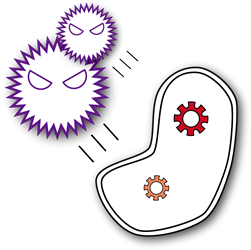Team:UT-Tokyo/Project
From 2010.igem.org
Overall project
We are now tackling on three projects; Allergy, Sudoku and Salt. In the Allergy project, we plan to modify E.coli to be used as an allergy cure by applying hyposensitization therapy. The Sudoku project is designed to solve the popular mathematical puzzle Sudoku by using “intellectualized yeasts”. In the Salt project, our yeast will collect excess salt in our intestines to keep our body’s salt level normal.
Project Details
Allegy
A lot of people are suffering from allergy every year. People sneeze and have trouble in stuffy nose because of house dust or pollen etc. Here, we mainly focus on the pollen allergy that is causing serious problems in many countries.
To tackle on this problem, we use hyposensitization therapy which makes our body accustom to antigens by intaking them little by little every day. Our E.coli will constantly produce epitopes in our intestines, and the epitopes will be recognized by antibody.
Here, we use epitopes of ceder pollen, but this method can be used in other types of allergy and we hope this method will be useful to cure allergy fundamentally.
Sudoku
Sudoku is a logical game to fill numbers from 1 to 9 inside the 9x9 boxes. The rule is simple: Each number should be used once in the same row, column, and 3x3 block.
In this experiment yeasts having information about the boxes will interact with other yeasts, and by applying a certain selection rule they decide the right numbers.
This process is a kind of parallel computation and it mimics differentiation in development.
Salt
Too much salt causes serious disease such as high blood pressure or stomach ulcer. We are aiming to create modified yeasts which intake salt overeaten inside human intestines.
In natural metabolic system transportation of Na+ is usually from intracellular to extracellular, so we aim to reverse the ion flow in our yeasts. This will be a great challenge to control one of the most basic cellular functions.
 "
"
